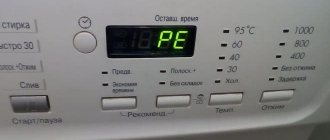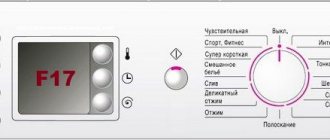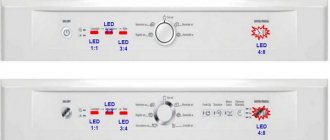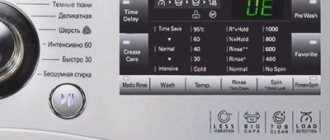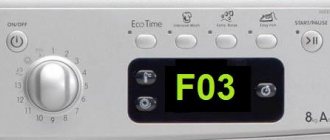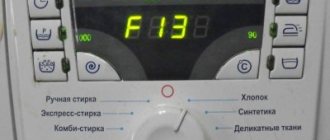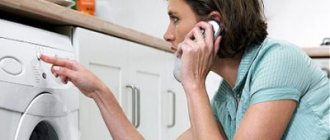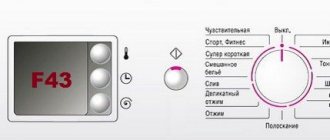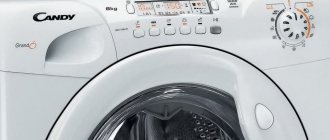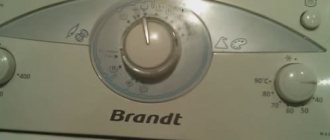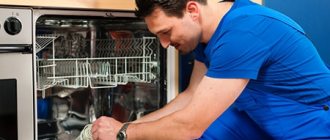Error E10 usually occurs in Electrolux machines at the very beginning of the cycle. At the same time, the washer does not draw water. Rarely does the error come on before rinsing: in this case, washing proceeds normally, but during rinsing the machine does not fill with water and displays code E10.
What does the code that the Electrolux washing machine produces mean?
Problems with water entering the tank (the process is blocked or water enters the tank very slowly) are displayed on the display of the Electrolux washing machine with error E 10 (alternatively, code C1 may be displayed).
If the washing machine does not have a display, the error code is read by the blinking of the indicators located on the control panel.
There are several options for deciphering signals about a malfunction. For Electrolux washing machines with an EWM 1000 control module, the error code is read by two indicators, one of which is located near the “Start/Pause” button, and the second near the “Wash End” button.
The indicators flash alternately. The number of blinks of the first indicator corresponds to the number of the error code, the number of blinks of the second indicator corresponds to the second number of the code.
Models of Electrolux washing machines with an EWM 2000 control module are distinguished by a more complex scheme for recognizing error codes. To decrypt, use eight light bulbs located on the right side of the control panel. The four upper lights are responsible for the first digit of the code, the four lower lights for the second digit of the washing machine error code.
The serial number of the indicator is determined from top to bottom. In case of error E10, only the first of the top four indicators is lit.
You can find out exactly which control module is installed on a specific Electrolux washing machine on a plate attached to the body of the household appliance or by markings that can be seen on the back of the control panel.
Error codes for Electrolux washing machines: causes and solutions
Coded symbols on the display of an Electrolux washing machine indicate problems with its operation. By studying the error codes of Electrolux washing machines, you can quickly find a faulty unit or breakdown.
E11: water is not poured into the tank or has not had time to fill
There was a water supply failure during washing. She is missing or has not had time to gain enough. Possible reasons:
- the solenoid valve does not work and water does not flow;
- there is no signal to open the valve;
- there is no pressure and the water is slowly gaining;
- pipe systems are clogged.
You don't need experience or many tools to fix the problem:
- Reboot your system. Turning the appliance back on again starts the normal washing process.
- Wait until the water pressure returns to normal. If the machine did not manage to draw water within the allotted period of time, the processor will also generate an error.
- Check the water supply and supply pipes. They may be clogged. Over time, deposits on pipes form scale, which prevents the normal flow of water.
- Carry out a diagnostic test of the current-carrying conductors of the valves for rupture. The vibration effect during operation of the machine disrupts the contact of the terminals.
- Ring the valve coils, check the resistance.
- If the actions do not help to restore the operation of the device, replace the control unit.
Error E10 is also common in Electrolux washing machines. It is consonant with E11 and has an identical meaning.
E13: a leak has occurred, liquid has entered the pan of the machine
Error E13 in Electrolux washing machines is displayed when water leaks into the pan. To make sure there is a problem, look for a crack in the housing. The problem appears after using the device for a long time. Pipes and cuffs often burst.
In cars, short circuits may occur in the wires that go to the leakage sensor. It is located next to the washer tray. In the middle of the pan there is a connector for draining liquid. It contains a sensor. When the container is filled with water, the float closes the sensor circuit. For repairs you will need the help of a specialist.
E21: problem with water drainage
A code error is displayed if the water has not drained from the drum within 10 minutes. Clean the filter, pipes and hoses. Check the pump coil resistance, it should be around 200 ohms. Another cause of failure may be a defect in the electronics module.
Error E20 in an Electrolux washing machine also indicates problems in the drainage system. Other possible designations of faults in the drain system: EF0, EFO.
E23: triac broken
The triac in the car burned out, which is located on the electronic board. He is responsible for the operation of the pump. To repair the device, test the control module and replace the triac with a new one.
E24: problem between pump and triac
If problems occur again when draining water, look at the contacts between the triac and the pump. The cause of the breakdown may be faulty wiring. Conduct wiring diagnostics, isolate damaged areas or completely replace the cable.
E31: problem with level relay
If the relay breaks, problems appear with displaying the water level in the machine. Replace the old level sensor with a new one. Before replacing, conduct a wiring diagnosis.
E32: pressure switch failure
If the pressure switch is faulty, error E30, E32 occurs. Replace it with a new one and repair the wiring that connects the part to the control module.
It gives an error in the following cases:
- The water supply valve is not turned to the open position;
- weak pressure;
- complete absence of water in the system;
- the filler filter is clogged;
- The relay tube burst.
Clean the filter regularly and replace the tubes if necessary.
E33: incorrect operation of the protection sensors
The sensor tubes are damaged or the pressure switch is broken. Conduct diagnostics of the device, check the voltage in the outlet using an ohmmeter.
E34: problems with the anti-boil level and pressure switch
In case of error E34, check the pressure sensors and electrical circuits. Replace the pressure switch tube.
E35: the water limit in the drum has been exceeded
As a result of the tank being overfilled with liquid, problems with the pressure switch occur. Inspect the device and install a working element.
E36: heating element relay malfunction
If the protection relay fails, check the functionality of the sensor. If necessary, replace the part.
E37: failure of the 1st water level sensor
The error indicates a sensor malfunction. Inspect the device, diagnose and replace the element.
E38: no signal from pressorate
If there is no signal about a pressure change, then the relay tube is clogged. Clean the tube or replace the element.
E39: overflow fault
Check the overflow pressure switch. Replace the part if necessary.
E3A: heating element relay malfunction
If the device generates this error, replace the relay or heating element.
E41: the door is not tightly closed
Errors E40, E41 indicate that the door is not fully locked.
E42: malfunction of the door locking device
UBL requires checking and replacing the lock.
E43: control board triac malfunction
The board's triac is responsible for the operation of the UBL. If it breaks, diagnose the board and replace the element.
E44: problems with the door close sensor
If the door closing sensor is broken, it must be completely replaced.
E45: UBL wiring fault
When the wiring contacts between the module and the UBL are faulty, repair the lock circuits.
E51: problems with the motor triac
Error E51 occurs when there is a short circuit. The motor triac burns out and requires repair or complete replacement.
E52: lack of contact between the tachogenerator and the block
This error occurs when the fastening washer has fallen off. The coil moves and the data supply to the controller is lost. Return the coil to its original position or change the tachometer.
Possible reasons
In practice, there are many reasons that can lead to error E10. The SM can record an information code on the monitor in the following cases:
- in the absence of water in the general household water supply system, in other words, the cold water supply is turned off;
- if the water intake hose is damaged;
- when the filling valve fails;
- if the pressure switch is faulty.
In some cases, self-draining of water from the tank occurs, and spontaneous leakage of water from the tank of the washing machine occurs - it becomes the result of some serious internal failure. Some Electrolux machines of the latest models with an extensive coding database can clarify the reason for the suspension of the unit, indicating a specific malfunction in the operation of the entire system.
However, the vast majority of the company’s units do not have this option, so they are limited to the E10 information code. If the washing machine could not indicate a specific part that had failed, then when carrying out repair work you will have to keep in mind all of the listed factors.
Table with information codes (error codes)
In the table below, we have listed the error codes for Electrolux washing machines, a brief description of possible problems and the reasons for their occurrence.
| Error code | Problem | Causes |
| E10 , E11 | The machine does not fill with water | Poor water pressure or lack thereof, blockage in the water inlet system, breakdown of the inlet valve, control module semistor |
| E13 | Leakage in the system | The tightness of hoses, connections or tank is broken |
| E20 , E21 , EF0 , EF1 , E23 , E24 | The machine does not drain water | Blockage in the drain or sewer system, breakdown of the drain pump or control module |
| E31 , E32 , E33 , E34 , E35 , E38 | Problems filling the tank | Incorrect operation of the pressure switch |
| E40 , E41 , E42 , E43 , E44 , E45 | The washing machine hatch is not closed | Entry of foreign objects into the hatch opening and the lock mechanism, deformation of the cuff, breakdown of the door locking system and lock mechanism, malfunction of the control board |
| E51 | Motor triac is faulty | The motor triac burned out as a result of a short circuit |
| E50 , E51 , E53 , E54 , E55 | Incorrect motor operation | Malfunctions in the operation of the motor itself, its winding, triac or circuit connecting the motor and triac |
| E52 , E56 , E59 | Incorrect operation of the tachogenerator | Malfunctions in the operation of the tachogenerator and its contacts |
| E57 , E58 | Problems with the motor | Mains voltage too high |
| E61 , E62 , E66 , E68 , E69 , E3A , E71 , E74 | The machine cannot heat the water or heats it too much | Incorrect operation of the temperature sensor or heating element |
| E90 , E91 | The washing machine does not respond to commands from the dashboard | Lost communication between the control module and the washing machine panel |
| EF5 | Drum imbalance | The drum is not loaded correctly, the machine is not level. |
| EF2 | Excessive foaming | Using too much powder or poor quality product |
| EH1 | Supply voltage frequency does not comply with permissible limits | Problems with the electrical network or control module |
| EH2 | Mains voltage too high | Electrical problems |
| EH3 | Mains voltage too low | Electrical problems |
How to fix it?
You need to start repair work with the most basic action - make sure that cold water enters the system. This is not difficult to do - you just need to open the bathroom or sink faucet and see if water flows from it. If everything is in order, then it’s worth checking to see if the valve where the inlet hose is attached is blocked - often equipment owners forget to open it before turning on the machine.
The issue of error E10 can also be affected by the water pressure - it should not be too weak. Owners of dachas and country houses often face a similar problem in the summer, when during irrigation hours all the neighbors turn on the water en masse. The pressure is noticeably reduced, this can lead to freezing of the working SM.
If there is a filter between the tap and the inlet hose, then you need to check it carefully - it may become clogged with sand or other impurities contained in the process water. A similar inspection should be carried out on the catch grid, which is located in the area where the hose enters the SM. It is possible that the blockage is located directly in the hose - then you need to disconnect it, carefully inspect it and make sure it is passable, that is, check whether it allows liquid to pass through.
Please note that any dirt plugs in the hose can only be removed under strong water pressure. The use of sharp wire and chemical reagents damages the integrity of the part.
Be sure to make sure that the collected liquid does not come out of the reservoir on its own. To do this, you need to lean towards the operating unit and listen. If you notice that water is bubbling in the drain, and then the unit displays error E10 and the operation of the machine is suspended, it means that you need to correct the situation and eliminate the self-draining. First, they look at the condition of the drain hose; it is probably twisted, jumped off, moved, or is below the permissible level. Under no circumstances should it pass along the floor; it should be raised by 50-70 cm.
There should be some air circulating in the hose, so do not lower it too deep into the drain.
If it is not technically possible to install the machine in strict accordance with the rules, then you should additionally resort to using a check valve; it will protect the machine from unauthorized draining. This part is quite inexpensive, and you can always install it yourself.
If the drainage is organized according to the requirements, and the liquid flows into the machine unhindered, but the volume of washing liquid is still not enough, most likely the breakdown concerns internal elements - the water level sensor, inlet valve or pressure switch. It is difficult to diagnose a pressure switch without basic skills and knowledge. To do this, you need to disconnect the washing machine from the electrical mains, turn off the tap responsible for supplying liquid to the tank and remove the top cover of the washing machine by unscrewing the screws holding it. Having carried out these steps, you will gain access to the sensor, then carefully press out the clamp holding it and moving it and disconnect the pressure hose.
To check the operation of the pressure switch, you will need a tube of the same diameter as the sensor fitting. It needs to be attached to the fitting and slightly blown. If the sensor is in good condition, you will hear 1 or 3 clicks - they indicate that the contacts have worked. After this, the pressure switch should be inspected for visible defects; if you notice dirt or debris inside the pipe, carefully rinse the part under running water.
To check the functionality of the pressure switch, a multimeter is usually used. This device is set to resistance mode and its probes are placed on the sensor contacts - the readings on the device monitor should change. If they remain the same, then the element is faulty and requires a complete replacement. Less commonly, the cause of the malfunction is the failure of the electronic module; problems with it are indicated by the following signs: water is being filled into the tank, the washing is running, but from time to time the unit pauses and displays error E10.
After turning the Start button off and on again, the program continues to work. This directly indicates problems with the electronics; they may be the result of improper factory assembly, unstable mains voltage parameters, or physical wear and tear.
This type of breakdown is considered one of the most serious and requires the involvement of a washing machine repair technician.
Common Mistakes
Washing machines of the Electrolux, Zanussi and AEG brands are manufactured by the same company and are equipped with the same control modules, so the error codes do not differ. There are quite a large number of information codes, so it is convenient to combine them into groups depending on the types of failure.
Before you begin inspection and troubleshooting yourself, you need to read the operating instructions for the equipment.
Error codes related to water inflow and drainage
Information codes E10 and E11 mean that no water is flowing into the washing machine, or the time allotted by the program to fill the tank has been exceeded. The simplest reasons for such errors may be turning off the water in the house or accidentally closing the tap supplying water to the installation.
If, after checking the water pressure, the machine still cannot start washing, you should inspect the inlet hose and the filter located at the point where the hose is attached to the washing machine, and remove any blockages. The hose may become bent, then it should be straightened.
If there are problems with the water supply, first of all you need to check the serviceability of the corresponding hose
If the washing machine fills with water and immediately drains it, the problem may be that it is not connected to the drain properly. The place where the drain hose connects to the sewer must be higher than the washing machine tank, otherwise spontaneous draining will occur.
More serious malfunctions that will require calling a specialist are malfunctions of the fill valve (it may be stuck in the closed position, which is also indicated by error code EC1 ) or malfunctions of the control module.
The unit displays code E13 when water leaks into the washing machine tray. The cause of the problem may be depressurization of hoses and their connections, or damage to the integrity of the tank.
Error codes E20 , E21 and EF0 , EF1 indicate problems in draining water from the washing machine. The causes of the malfunction may be:
- clog in the drain hose, filter protecting the pump, or in the sewer;
- drain pump malfunction;
- malfunction of the control module.
First of all, check the drain hose and filter for blockages. The hose is disconnected from the washing machine and pipe, washed with running water or cleaned with a special cable. The filter is also easy to check yourself - it is usually hidden behind a door located at the bottom of the front panel of the washing machine. Sometimes drainage is difficult due to blockages in the drain. A sign of blocked pipes will be slow flow of water from the sink or bathtub.
To clean the drain filter, you need to open the door located at the bottom of the front panel of the washing machine.
If after these manipulations the error does not disappear, you need to call a specialist to inspect the drain pump and check the control module.
Information codes E23 and E24 indicate a malfunction of the triac that controls the drain pump, or a failure of contacts between the triac and the pump. In both cases, the water will not drain.
Error codes associated with malfunctions of the pressure switch (water level sensor)
A pressure switch is a sensor that determines the water level in the tank of a washing machine; malfunctions in its operation are indicated by information codes E31 , E32 , E33 , E34 .
The reasons for the incorrect operation of the sensor may be clogging of its tube, disruption of contacts and communication with the control module. In rare cases, the occurrence of an error is associated with a clogged water inlet system. Error E33 may occur due to unstable voltage in the network and disappears only after it has stabilized.
You can check the serviceability of the wiring and pressure switch hose yourself
You can eliminate the error yourself by cleaning the pressure switch tube and checking its contacts. The sensor is usually located in the right corner under the lid of the washing machine. It is better to entrust the repair of other faults to professionals.
Error codes related to engine problems
There are quite a lot of variants of malfunctions that can occur in engine operation, as well as the codes indicating them. Errors E50 , E51 , E53 , E54 , E55 indicate disturbances in the operation of the motor itself, its winding, the seven-stor, or the circuit connecting the motor and the seven-stor.
A separate group includes information codes E52 , E56 , E59 , which indicate malfunctions of the tachogenerator - a sensor installed on the motor and monitoring its rotation speed.
The tachometer controls the speed of the electric motor.
Errors E57 and E58 indicate increased voltage levels in the network, which in turn may lead to the need to replace the washing machine motor, control module or wiring.
It is better to entrust troubleshooting related to engine operation to a specialist.
Error codes related to water heating
This group of information codes includes E61 , E62 , E66 , E68 , E69 , E3A , E71 , E74 . The washing machine cannot heat the water to the required temperature; it does it too quickly or, conversely, slowly. Since a heating element (tubular electric heater) and a temperature sensor are responsible for heating the water in the installation, the causes of errors will be associated with malfunctions in the operation of these parts, for example:
- failure of the heating element, its relay or contacts;
- breakdown of the sensor, its contacts, failure of communication with the control module.
In case of these malfunctions, you can try to check the contacts and resistance of the devices yourself. It is better to entrust repair and replacement of the sensor and heating element to specialists.
The heating element of a washing machine often fails due to the formation of limescale on its tube
Most often, the heating element of a washing machine overheats and fails due to scale that settles on its tube. To prevent the formation of plaque, you can periodically clean the washing machine, for example, with citric acid, or use water softening agents.
Error codes related to the operation of the hatch door
If the wash is started with the hatch door closed incorrectly, one of the following information codes will appear on the screen: E40 , E41 , E42 , E43 , E44 , E45, and the installation will stop working.
There can be several reasons for errors:
- door not closing tightly;
- foreign objects getting into the hatch or locking mechanism;
- deformation of the rubber cuff;
- malfunctions in the hatch locking system or control board;
- breakdown of the lock mechanism.
It should be remembered that under no circumstances should you close the car hatch using force. This may cause the door to jam, making it much more difficult to repair. If the hatch does not close, you need to check whether the laundry in the drum is interfering with it, or whether there are foreign objects under the rubber cuff or in the lock slot.
Repairing the washing machine door lock is best left to professionals.
Other manipulations, such as replacing the rubber cuff, checking the wiring of the lock mechanism or replacing it, diagnosing the locking system and control module, should be performed by professionals.
Other error codes
Error codes E90 and E91 indicate a breakdown in communication between the control module and the washing machine panel. In case of such malfunctions, the installation does not respond to button commands. To “remove” the error, you can try to reboot the machine. In case of failure, you need to contact the service department.
Information code EF5 means load imbalance when spinning the washing machine drum. Usually the problem occurs during the rinsing or spinning stage. The machine stops working and water often remains in the tank. The causes of the malfunction are usually:
- too much or too little laundry loaded into the drum;
- washing very large and very small items at the same time, which leads to them twisting;
- The machine is installed on an uneven surface.
In order to properly distribute the laundry inside the drum, open the hatch of the washing machine, after draining the remaining water in the tank through the emergency pipe or drain hose. If the machine is not positioned correctly, it is moved to a flat horizontal surface.
Information code EF2 indicates excessive foaming in the drum. The washing machine itself clears the error after the foam decreases in volume. If this does not happen for a long time, you need to drain the foam and water from the tank, remove the laundry and thoroughly wipe the drum and detergent compartment, removing any remaining powder. After cleaning is completed, you can start washing.
If you use too much powder when washing, foam will flow out of the machine.
How to reset?
In order to reset the error code in a washing machine with a program selector, you need to simultaneously press the buttons as shown in the figure:
For washing machines without a selector, the error is reset by simultaneously pressing buttons 2,4 (see figure):
Error e03
This error can occur in a situation where, for some reason, the pneumatic relay does not work correctly. Also, an error code e03 may appear if the traction sensor is faulty. Also, this malfunction can occur in a situation where, for some reason, there is difficulty in removing combustion products. This may be due to:
- improper installation of the chimney;
- chimney blockage;
- failure of the exhaust turbine;
- complete failure of the pneumatic relay.
The Venturi tube, which is used to measure the draft force in the smoke exhaust duct, may also be faulty. When the turbine starts, the pressure in the chimney changes, and this change is captured by the Venturi tube. The tube is connected to a pressure switch in which the membrane is located. The membrane reacts to pressure changes, and its movement closes or opens the contacts of the microswitch of the pressure sensor. Incorrect operation of these elements can cause error e03 to appear.
You also need to check the turbine itself. First of all, the presence of free rotation of the shaft is determined, and then the fan itself is checked. The presence of voltage at the terminals of the wire that comes from the electronic board is also checked. The windings of the turbine electric motor are also checked. Their resistance should be in the range from 38 to 48 ohms. If the resistance does not meet these parameters, the fan should be replaced.
Along with the turbine, you need to check the condition of the chimney and the correctness of its installation. The air relay must also be carefully checked for operation. You can use a pressure gauge to check.
Also, the cause of error E03 in Baksi gas boilers may be poor contact on the connectors that connect the electronic board to the turbine and relay. Poor contact can be caused by oxidation, which can occur when moisture gets into the connector.
In what cases can you fix error E10 yourself?
Problems that can be solved on your own are usually not related to automation, but are caused by external factors. These are the ones that can be easily eliminated without the involvement of specialists:
- The lack of water or weak supply depends on the water pressure in the plumbing system. This may be due to its complete absence on the line (accident, planned maintenance, etc.). Possible low pressure due to large water intake by many users at the same time. Another reason (most often happens in metal water pipes) is corrosion of the inner surface of the pipe and a narrowing of the diameter of the watercourse. Having resolved the issue with water pressure, we deal with the E10 signal. The error is reset by disconnecting and reconnecting the washing machine to the network.
Please note! To avoid the error occurring again, you should wait until the water pressure required for the washing machine appears, and only then start washing.
- There may be no water in the machine if the tap through which it is supplied is closed. Another possible version of the same problem is that the valve is not fully open, and it flows very slowly. After fully opening the shut-off valve and restarting the washing process, the error is guaranteed to disappear if there are no other reasons interfering with the operation of the SMA.
- When an error appears, the washing machine may respond to a slow flow of water due to a squashed or bent hose. To ensure the free flow of water, it is necessary to check the condition of the flexible supply tube and, if necessary, free it from kinks, clamps, etc. Repeated turning off and on removes the problem with error E10.
- The filter mesh of the filler tap, designed to retain mechanical impurities from the water supply system, is clogged. Often, the absence of a coarse filter (usually installed in front of the water meter) leads to the mesh filter quickly becoming clogged and requiring periodic cleaning. It is better to replace it with a new one, since cleaning it with a needle or soaking it in a special solution to remove limescale is a long and labor-intensive task. After completing all the steps and turning on the washing machine again, the error should disappear.
Attention! Work on cleaning or replacing the filter mesh must be preceded by disconnecting from the network and turning off the tap.
- Self-draining water. This problem occurs due to improper connection of the drain hose to the sewer pipe. Their connection must be at a level of 60 cm or higher, otherwise, even with normal pressure, water will drain from the tank. The problem can be solved simply; for this purpose, an additional loop is created above the specified height, but not more than 100 cm. A plastic arc-shaped holder from the washing machine kit serves this purpose. You can purchase it separately or bend and secure the drain hose yourself. The error when turning on the machine to the network will go away if this was the reason.
On a note! If for some reason the hose cannot be secured according to the rules, purchase a return valve and install it on the drain. Its task is to prevent arbitrary water from leaving the washing chamber of the machine. It costs little and is easy to install.
- A one-time failure of the control module can cause an error code to appear on the display. The most common cause is power surges. Unplugging for a few minutes helps.
If the listed reasons for the appearance of the E10 signal have been checked, and the error is still displayed on the control panel, then the problem is not with them.
Reasons for error E10
There are many conditions for error code E10 to appear on the control panel display. We list all the cases as far as possible:
- low water pressure or lack of water in the chamber;
- the valve supplying water to the SMA is closed;
- the water supply hose is kinked or crushed;
- the filter network of the filling valve is clogged with debris or dirt;
- spontaneous drainage of water;
- one-time failure of the control system;
- the intake valve is damaged;
- the pressure switch has failed;
- The control unit is acting up or burnt out.
These are the most common reasons that provoke the appearance of the E10 signal. Some of them can be fixed on your own, others can only be fixed at a service center.
Let's look at each group of problems in more detail.
Possible faults requiring repair
In a situation where all possible cases of an error have been investigated, but the cause cannot be found, only one conclusion is possible: a breakdown of one of the mechanisms or devices of the washing machine. It is difficult to determine them on your own, so calling a specialist would be the most correct solution. In what cases can you not do without it:
- The control unit is damaged. Cause: burnt out circuit elements. Both repair and installation of a new module are possible;
- The water supply solenoid valve has failed. There may be two reasons: a blockage or a burnt out coil;
- breakdown of the level sensor (pressure switch), which most often gets stuck due to accumulated dirt. In such cases, it signals that the tank is empty. In another situation, overflow is possible due to the fact that the sensor did not send a “stop” signal to the control unit. There may also be problems with the hose connecting the sensor tube to the camera. The repair consists of cleaning the pressure measuring chamber from dirt deposits, replacing the supply hose or the level sensor itself with a new pressure switch.
Trouble-shooting
Owners can correct possible faults from the first group on their own. All possible options have already been listed above.
Important! The algorithm for eliminating any malfunction should begin with a careful inspection of the external surface of the washing machine, especially its rear part.
To prevent the recurrence of error E10 in the Electrolux ACS, preventive maintenance of water filters and other elements should be carried out regularly, and all mechanisms should be connected according to the manufacturer’s instructions.
The second group reflects breakdowns that need to be corrected with the help of service center specialists. They will not only diagnose the washing machine and replace the failed unit, but will also give it a guarantee.
Causes
Each of the error codes has a reason (and often more than one) for its occurrence. Thus, error code E11 usually occurs when one of the water inlet valves or its control circuit on the electronic controller breaks down. This is the most common, but not the only reason. Among others, there is insufficient resistance of the valve winding (the norm is 3.75 ohms), insufficient water pressure in the water pipes, and clogged water inlet path.
If problems arise with draining water (error code E21), it is worth checking the serviceability of the drain pump, the permeability of the filters, pipe and drain hose. It is the malfunctions and contamination of these elements and components of the machine that most often become the cause of this type of breakdown. It also makes sense to check the voltage of the drain pump winding (the norm is 170 Ohms). Finally, the cause of this type of error can also be a malfunction of the electronic controller.
Error EF1 may also be associated with exceeding the drain time, and the display of code EF2 indicates an increase in foaming, the root cause of which is also a clogged drain line. In this case, the origins of the problem are sought in the drain hose or sewer; it makes sense to check the filter above the drain pump for clogging.
The causes of failure of the pressure switch are mainly caused by clogging of the tube, malfunctions in the electrical network, and failures in program settings. The pressure switch is responsible for the overall performance of the washing machine, otherwise it is called a water sensor and a voltage sensor. That is why the failure of this element leads to the appearance of completely different “symptoms” - premature start of washing, inability to activate the laundry spin function.
The causes of errors E40-E43 are related to the hatch door not being tightly closed. This could be due to debris or foreign objects getting into the lock. That is, the search for the cause of the malfunction begins precisely from this zone. If everything is in order with the lock, then the cause of these error codes may be a misalignment of the door. That is, the screws in the bolts have become loose, the door has “slipped”, so it is impossible to close it correctly. It is clear that in this case you should tighten the bolts with a screwdriver and return the door to the desired position.
Sometimes the reason for a door that is not tightly closed may be hidden in voltage surges. You can check this in a simple way - unplug the washing machine from the power supply for 10-15 seconds, and then turn it on again. As an option, try manually pressing the door to the hatch with your hands and wait to see if a characteristic click is heard and a lock icon appears on the display.
Finally, the cause of the door not closing tightly can be wear and tear on the machine parts. On average, they are all designed for a 5-year service life. Problems with the operation of the electric motor can be identified by the appearance of error E50 on the display. Moreover, the cause of its occurrence may be a malfunction of the relay, bearings, or lack of a signal from the tachogenerator.
The reasons for this are also different - from a washer that has slipped off the thread to serious malfunctions of the tachogenerator and its natural wear.
One of the weak points of washing machines is the heating element. One of the common causes of heating element failure is the formation of scale on its surface. Scale does not allow heat to pass through, that is, the heating element begins to overheat, and the heating of water during washing turns out to be insufficient.
The formation of scale is usually associated with high levels of water hardness, the presence of foreign impurities in it, primarily calcium and magnesium salts (this is why deep cleaning filters for water pipes are recommended for use), and too aggressive detergents.
Sometimes the heating element, on the contrary, heats the water too quickly and too much. In this case, the temperature sensor is to blame and should be replaced. The relays that control the functioning of the heating element may also fail.
All elements are working properly, but the error signal does not disappear
We figured out how to fix the problem. But sometimes a situation arises in which an error known to us can disrupt the operation of a washing machine for no reason. To be more precise, the problem still exists, but it is not related to the flow or drainage of fluid, and the units responsible for this function normally. It turns out that the machine is washing, but an alarm signal is displayed on the screen.
In this case, an experienced specialist will have to deal with this situation, since it is not recommended to dismantle and test the control unit module yourself if you do not have the appropriate skills for this.
Elimination
So, one of the common problems is the absence of signals on the display when the machine is connected to the network. Simply put, she does not react in any way to such actions. First of all, you should check whether there is electricity in the network - plug in other equipment into the outlet.
You can try to reset the washing program and enter it again.
If everything is ok, check the power cord and plug. If damage is found, do not isolate, but replace. The cause may also be oxidation of the control panel contacts or burnout of the surge protector or its elements. Troubleshooting this type of problem begins with removing the top cover (just unscrew the bolts). You will see the filter against the wall. When it burns out, swelling will be noticeable. In this case, the filter must be replaced. To check the keys, you must first remove the tray, after which the buttons will be visible (behind the module).
In case of contact oxidation, the element is replaced.
If there are problems with water intake and drainage, the first thing to do is close the shut-off valve and unscrew the hose from the housing. A filter will be found behind it; it is removed and washed under water; the same should be done with a hose. It makes sense to immediately dismantle the back cover and check the inlet valve located behind it with a multimeter (the norm is 2-4 Ohms).
If there is water left in the tank, you should also clean the drain. You can find it behind the door located at the bottom of the machine (from the front). When you open this door, you will see a filter that needs to be unscrewed. Attention, at this moment water will flow out of the hole, so you should immediately prepare rags and buckets. After unscrewing the filter, it is washed, as well as the space that it covers.
It is worth wiping the filter dry and screwing it back in.
If the drum begins to wring out clothes poorly, and the machine vibrates strongly, you should check the tension of the drive belt. To do this, you need to unscrew the back panel of the device. If the belt comes off, you will immediately see it; just return it to its place (on the engine pulley). When the belt wears out, it must be replaced. In machines with a classic engine, brushes may need to be replaced. You need to check their graphite rods (remove them from the case, disconnecting the contacts).
If more than half of the brushes are worn, they must be replaced.
Briefly about the main thing
Baksi gas boilers do an excellent job of heating a home and last a long time if used correctly. Errors e01, e03, e10 that occur can often be corrected independently without the help of a service specialist. In some cases, it is necessary to increase the pressure in the heating circuit, in others, to check the serviceability of the power supply. Self-checking the sensors and electrodes will also help determine the cause of the error. Knowing the mechanics of the boiler’s functioning, you can easily eliminate the malfunction that has arisen.
What does the code that the Electrolux washing machine produces mean?
Error code E20 appears in Electrolux washing machines if draining water from the tank continues for more than 10 minutes.
This may be due to malfunctions of the following parts:
- drain hose and sewer;
- drain pump (pump);
- filter, which is located in front of the pump;
- corrugated pipe between the tank and the pump;
- water level sensor (pressostat);
- an electronic control unit (ECU), which reads the sensor signals and starts the pump.
As a rule, during the washing process the user sees only code E20. You can more accurately determine the location of the breakdown using the diagnostic (test) mode.
To enable this function, you need to hold down the “Start” button and the one closest to it, and then switch the program selector to one of the positions. The drain and spin test is carried out in the eighth position of the handle.
After starting the diagnostics, another code may appear on the display: E21, E23 or E24. There are separate codes to indicate breakdowns of the pressure switch (E31-E35, E38), so error E20 most often indicates problems with other components of the drain system.
In automatic washing machines (CMA) without a display, the code is displayed using special indicators, which are located on the right side of the front panel. The eight light bulbs are divided into 2 groups: upper and lower. You can determine the error code using the number of the lit indicator in the group.
Indication of drain system errors on SMA without display:
| Indicator | E20 | E21 | E23 | E24 |
| Upper | ||||
| №1 | — | — | — | — |
| №2 | + | + | + | + |
| №3 | — | — | — | — |
| №4 | — | — | — | — |
| Lower | ||||
| №1 | — | + | + | — |
| №2 | — | — | + | — |
| №3 | — | — | — | + |
| №4 | — | — | — | — |
In older models with an EMW1000 series control module, the error code can be determined by the number of flashes of the two indicators located near the Start button.
Everything is fine, but the error still appears
There are situations, although very rarely, when the displayed error signal E10 stops the operation of the washing machine for no reason. Attempts to find them lead nowhere. The operation of the units for supplying and draining water is impeccable, all conditions for water pressure, height of the drain hose and others are met, but the display still shows an error that stops the work. The electronic control unit is almost entirely to blame for this problem. It may fail due to power surges or frequent unscheduled stops of the washing machine, for example, the cord being pulled out of the network for some reason. A factory defect is also possible, which usually appears in the first months after purchasing the unit.
In any case, this should be clarified by specialists with special knowledge and the equipment necessary for testing.
Modern automatic washing machines are capable of diagnosing their condition and displaying a message about the problem on the display screen, highlighting the error number assigned to it; the signal can also be an audible one. In some models, the light and sound signals work in pairs. The point, however, is not this. Eliminating errors through diagnostics and subsequent repairs is only possible with human hands, and for this you need to have at least basic skills and knowledge in solving such faults.
Causes, diagnosis and solutions
The causes of a malfunction of the drain system can be:
- Mechanical blockage of the hose, filter, internal pipe, pump or sewer.
- Kink in the drain hose.
- Damage to the pump impeller due to a foreign object.
- Failure or manufacturing defect of the pump's electrical system.
- Disconnection, destruction or oxidation of the contacts of the pump and the electronic unit.
- Combustion of tracks and radio elements on the ECU board.
The appearance of code E20 on the display does not always indicate a critical breakdown. It can occur due to a one-time malfunction of the electronic module or a slight blockage that can be eliminated within 1-2 minutes.
When error E20 appears, you must:
- disconnect the SMA from the power supply for 10-15 minutes;
- inspect the drain hose for kinks;
- remove it from the sewer pipe, place it in a large basin or sink;
- start the drain program.
If the error occurs again, you must turn off the unit and begin diagnostics. If the water is draining normally, you should check the permeability of the sewer and install the hose in place.
Clogged drain filter, pipe or hose
A clog in the drain system is one of the easiest SMA problems to fix. To restore the operation of the unit, you must:
- Turn off the washing machine.
- Remove the bottom panel on the front of the unit, behind which is the drain filter.
- Cover the floor under the filter with an absorbent cloth and place a wide, low container. Turn the handle and remove the part.
- After removing water from the tank, disconnect the drain hose and check it for blockages using a stream of running water.
- Inspect and wash the filter. Use your fingers to clean the seat.
On Electrolux top-loading models, the drain filter is accessed through the tank, so you need to remove the laundry before draining the water.
To check the pipe, you will need to partially disassemble the washing machine. This part is secured with clamps at the outlet of the tank and the inlet of the drain pump.
Drain pump failure
If the drain is not blocked, then the problem may be a faulty pump. Error E20 can appear in several cases:
- the pump impeller is jammed with a small object;
- one or more pump blades are broken;
- the pump electric motor burned out;
- The pump contacts have oxidized or become disconnected.
To check and repair the pump, you will need to disassemble the SMA and disconnect the wires and hoses. After this, you need to dismantle the pump, examine the impeller and check the resistance at the contacts with a multimeter (nominal value is about 170 Ohms).
A breakdown of the pump motor can be determined by the absence of a characteristic hum at the beginning of the drain. If the motor or impeller is broken, the sump pump will need to be completely replaced. In other cases, the part is repairable.
Electronic unit malfunction
If, if the pump is clogged or malfunctioning, only errors E20 and E21 appear on the display, then if there is a problem with the computer, codes E23 and E24 may also appear.
Problems with draining water may occur due to the following failures of the electronic module:
- broken wires or oxidation of contacts (E20, E24);
- module firmware failure (E20, E21);
- breakdown of the pump control triac (E23);
- defective pump control circuit on the board (E24).
To restore the operation of the SMA, the technician checks the functionality of the radio elements, cleans and solders the defective tracks, and, if necessary, reprograms the board. If a large number of tracks or the processor is damaged, a complete replacement of the module is necessary.
What causes error E20 to occur in an Electrolux washing machine? Review +
Zanussi and Electrolux household appliances have rightfully earned the love of their customers due to their reliability, durability and ease of use. Washing machines of these brands did not stand aside either. A large selection of models from this manufacturer is ready to meet any requirements of its customers.
The machines have different dimensions, methods of loading laundry and a huge range of functionality. The devices are very easy to use thanks to carefully thought-out functionality that anyone can handle.
The machines of this brand are equipped with a function to recognize their emerging faults, which makes it much easier to deal with them.
- Many malfunctions do not necessarily arise due to the fault of the device; most of the reasons for the incorrect operation of the washing machine are related to its operating conditions, due to the fault of the user and various environmental factors. One of these reasons for malfunction is a failure in the drain system of the product.
- As a result of such a problem, the device will notify us in various ways with error code e20. On newer models with a display it will look like this, but on older models the code will be indicated by lighting up a certain combination of information LEDs and blinking a number. But the method of notifying us about a malfunction is not so important, what is important is what it tells us and how to deal with it.
- Let's look at a number of reasons why an error occurs in an Electrolux washing machine. Most of them arise not at all due to the failure of device parts, but precisely because of the operating conditions.
Causes of failure with code E20
A malfunction with code E20 is usually displayed on the machine’s display. This error tells the machine user that the machine cannot drain waste water after washing. In this case, the device may not drain water at all or may drain water, but at the same time, the signal indicating that the drum is empty does not reach the electronic module boards.
The main reasons for the incorrect operation of the machine are blockages or kinks in the hose through which water is drained, blockages in the drain filter, blockages or damage to the pump, damage to the pump winding, and faulty contacts leading from the pump to the control module. In the worst case scenario, the electronic module itself breaks down.
Repair methods
Before starting repair work, you should disconnect the machine from the power supply and drain the water from the drum using a drain hose. When draining, you need to pay attention; if water comes out without any problems, then the problem is either a clogged sewer or a pump. Then just take the laundry out of the machine and you can start troubleshooting.
First, check the siphon into which the water is drained. If there are no blockages in it, then you should move on to checking the drain pump and filter. After removing the filter, check it for blockages and, if there are any, get rid of them.
If the filter was clean, then proceed to removing the pump. In washing machines from Electrolux, the pump is located next to the back wall. You will need to remove the back cover of the machine and disconnect all contacts from the pump. Then we climb under the bottom of the device, there we unscrew the bolt that holds the pump. Next, remove the bandages from the drain hose and pull out the pump.
First check the pump for damage. If it is damaged, it must be replaced. If it is externally intact, then it is worth checking it for blockages. To do this, unscrew the cap and check the impeller. Cleaning should be done with care so as not to damage the pump.
You'll be lucky if the problems were related to the pump. After cleaning, install it back and run a test wash. If the drain works, then everything turned out well. However, if there is no drain, you need to continue diagnosing the machine.
At this stage, we should check the wires that lead from the pump to the control module. It is worth checking them for damage. If there are minor damages, then you need to use electrical tape and rewind this wire. In case of major damage, the wire must be replaced.
At the very end, after a complete analysis of the hose, filter, pump and wires, we can conclude that the problem is in the control module. It is no longer possible to deal with such a breakdown on your own, because for repairs you need to have the appropriate equipment and a diagram of the module boards. To fix this problem, you will need to replace the burnt boards. This is a very hard and responsible job.
What is this code that the Electrolux washing machine produces?
The Electrolux washing machine signals problems with the hatch locking with error E40. There are many reasons why the seal of the hatch closure is broken. Deciphering the E40 information code helps to more accurately determine what exactly caused the malfunction.
To enter the diagnostic mode of the Electrolux washing machine without a software selector (the washing mode is selected by pressing individual buttons), you must simultaneously press and hold two buttons in the right corner of the control panel (pictured item 1) and one large round button located on the right sides (pictured item 2).
As soon as all the indicators flash simultaneously (a signal that entry into the diagnostic system was successful), a code will appear on the display that pinpoints the cause of the washing machine malfunction:
- E41 - the hatch door is not tightly closed;
- E41 - the hatch locking device has failed;
- E43 - the triac responsible for the operation of the UBL has failed (additional diagnostics of the control module is required);
- E44 - the hatch door opening sensor is faulty;
- E45 - break in the eclectic circuit between the triac and UBL.
For models of washing machines with a program selector (the washing mode is selected by turning the knob of a special switch), to enter the diagnostic system, you must press and hold the two outermost buttons on the right side of the control panel (item 2 in the photo).
In Electrolux washing machines without a display, problems associated with locking the hatch door are indicated by flashing indicators.
In models with the EWM 1000 control module, the code is transmitted by two indicators: one located near the “Start/Pause” button, the second - near the “Wash End” button. The indicators flash in turn, with a short pause. The number of flashes determines the two-digit value of the fault code. In the specific case of error E40, the indicators flash once four times.
For washing machine models with an EWM 2000 control module, error code recognition is carried out in a slightly different way. To obtain the necessary information, count the number of blinks of the eight indicators located on the right side of the control panel. The number of blinks of the four upper indicators is the first digit of the error code, the number of blinks of the second four indicators is the second digit of the code.
For a specific error E40, only the third indicator out of the top four blinks four times. The serial numbers of indicators are determined from bottom to top.
About Baxi gas boilers
Baxi gas boilers have been present on the heating equipment market for quite a long time, and have shown their best performance. These heating devices are quite reliable and easy to maintain, and are assembled from high-quality components. Baxi have an adjustable flame level, which allows you to more accurately maintain the set temperature. The adjustable flame allows you to operate the boiler in a gentle mode, since the number of turns on and off of the boiler is significantly reduced. This feature allows the burner nozzle to last much longer, and also increases the life of the heat exchanger. All this is because adjustable flames reduce the frequency of heating and cooling of the heat exchanger, which has a positive effect on its service life.
Also, heating devices of this brand are famous for their efficiency, and they save not only gas, but also electricity. Baxi boilers are equipped with several temperature sensors that are located inside the boiler. But it also provides for the installation of remote temperature sensors that can be installed from the street side. With this arrangement of sensors, the boiler itself will respond to changes in air temperature outside the window and select the most optimal operating mode.
Despite the many innovative technologies used in heating devices of this brand, Baxi boilers are famous for their light weight and compactness. Even the floor-standing units from this manufacturer are quite light and small-sized. Baksi boilers are incredibly reliable, since all systems of this device are controlled by an electronic control unit. The electronics monitor all parameters of the boiler’s operation, and if the slightest malfunction occurs, the boiler’s operation stops and the error code is displayed on the liquid crystal display. Each code encrypts information about a particular malfunction, and decoding this code allows you to quickly identify the malfunction and eliminate it. Errors come in the following names.
Why does it appear and what to do?
The process of eliminating error E40 of the Electrolux washing machine is carried out according to a clearly defined algorithm, starting with the simplest actions, gradually moving towards more complex repairs that require certain knowledge and training.
Checking the tightness of the hatch door
The first thing you need to do when the washing machine signals a malfunction with error E40 is to open the door, check the rubber seal of the hatch for stuck debris, and close the hatch door again (press until it clicks).
Additionally, check the condition of the hinges (door misalignment can also trigger error E40). It is enough to tighten the fasteners that have become loose over time so that the hatch door fits hermetically to the body of the washing machine again.
Testing and changing the hatch locking device (UBL)
The absence of a characteristic click when closing the hatch doors is a signal that the possible cause of the E40 error lies in a malfunction of the hatch locking device (UBL).
Algorithm of actions:
Open the hatch of the washing machine.- Using a flat screwdriver, carefully pry it off and tighten the metal ring (clamp) holding the rubber seal of the hatch inlet.
- Having bent the cuff, using a Phillips screwdriver or a tool with an asterisk attachment, we unscrew the fasteners holding the UBL.
- By pulling the lock to the left, carefully remove it from its seat.
- We check the dismantled lock with a tester. To do this, switch the multimeter to the “Resistance” mode. We apply one probe to the neutral contact, the second to the phase. The tester changes the readings - the UBL is working.
- We apply the tester probe to the neutral and common contact. If “0” is displayed on the multimeter display, the UBL is faulty and requires replacement.
- We disconnect the faulty lock from the wiring and connect a new part in its place.
After replacing the lock, return the clamp and rubber cuff to their original place, and run a test wash.
We eliminate contact breaks between the UBL and the control module
Very strong vibration of the washing machine, long-term operation of the household appliance in a damp room leads to disruption of the integrity of the contacts between the hatch locking device and the control module. In addition to error E40, a similar problem is indicated by a burning smell that occurs when starting the wash.
To troubleshoot the problem you must:
- carefully inspect the UBL contacts for breaks, burnt areas (additionally, the wiring is tested with a multimeter);
- clean damaged areas, solder breaks.
Before starting work, you must make sure that the washing machine is disconnected from the power supply.
Restoring the operation of the control module
Very often, error code E40 (in diagnostic mode E43, E45) indicates that the reason for the lack of locking of the hatch doors lies in the control module. Sudden voltage surges or moisture entering the washing machine body lead to burnout of elements in the UBL circuit.
To diagnose and fix the problem, you must:
Remove the cover of the washing machine (unscrew the rear panel bolts).- Remove the powder receptacle, unscrew the fasteners in the opened niche, and remove the control panel from the latches.
- Having carefully examined the control module, determine the burnt-out elements (damaged areas are distinguished by black color, convex capacitor caps), and resolder the necessary areas.
In the absence of knowledge, experience and skills in repairing the control module, it is better to entrust such work to the professionals of the service center.
The expansion tank is faulty with error e10
Almost all models of Baxi gas boilers are equipped with an expansion tank, which is necessary to compensate for the expansion of the coolant during heating. This device consists of two metal panels that are separated by a rubber membrane. One part contains coolant, and the other contains nitrogen or air. When filled, the air chamber has a pressure of 0.8 bar. It may happen that the pressure in the expansion tank will be more or less than the nominal one, therefore, the heating system will not work correctly: the pressure of the hydraulic system will decrease or increase and error e10 will appear.
Using a special valve, you can check the pressure of the expansion tank, and also adjust it by pumping air with a car pump.
If you are not confident in your abilities and cannot identify the exact cause of this error, then it is better to contact an experienced specialist who will do his job efficiently.
If the cause of error e10 is incorrectly installed, there can be negative consequences. In our store you can buy spare parts for gas boilers inexpensively in Moscow.
